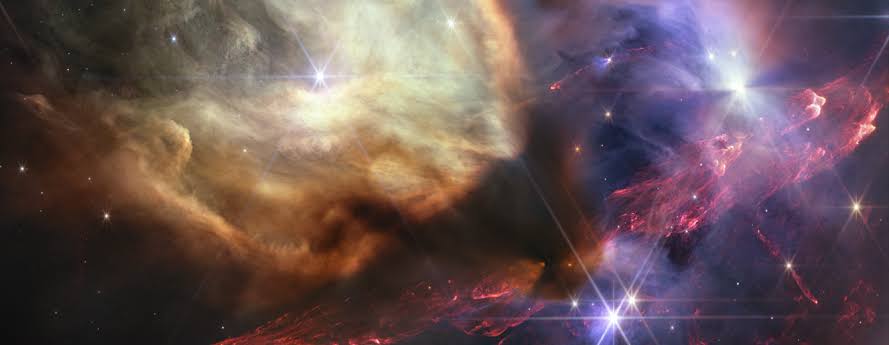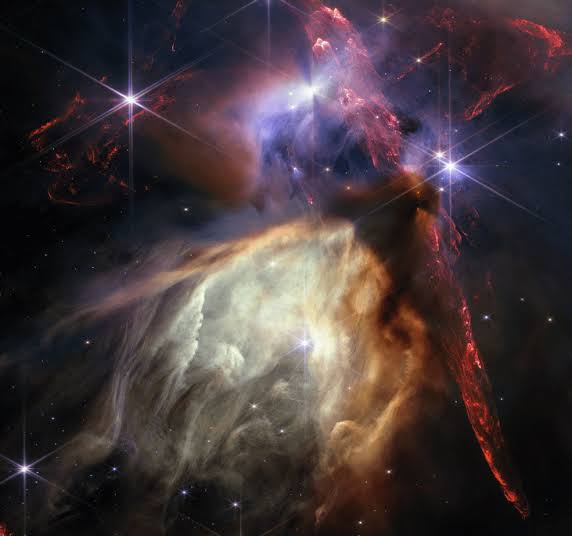NASA’s James Webb Space Telescope has completed its first year of science operations, surpassing expectations and providing unprecedented insights into the universe.
To commemorate this milestone, NASA has released an image captured by Webb showcasing a small star-forming region in the Rho Ophiuchi cloud complex. With its ability to peer into dust clouds and capture light from distant celestial bodies, Webb has revolutionized our understanding of the cosmos, enabling scientists to make groundbreaking discoveries.
The first anniversary image from NASA’s James Webb Space Telescope displays star birth like it’s never been seen before, full of detailed, impressionistic texture.
A New Perspective on the Cosmos:
Webb’s remarkable achievements in its inaugural year have transformed humanity’s perception of the universe. By capturing images from remote corners of the cosmos, the telescope has unveiled hidden wonders and provided scientists with an abundance of new discoveries.
Each image captured by Webb represents a scientific milestone, empowering researchers worldwide to explore and answer questions that were previously unimaginable.
A Close-up of Stellar Birth:
In celebration of its first year of operations, Webb has released a captivating image of the Rho Ophiuchi cloud complex, the closest star-forming region to our solar system. The proximity of this region, located just 390 light-years away, enables Webb to capture highly detailed close-ups without any intervening foreground stars.
The image showcases approximately 50 young stars, all similar in mass to our Sun or smaller. The densest areas, represented by the darkest regions, reveal dust cocoons surrounding protostars in the early stages of formation.

The Phenomenon of Bipolar Jets:
The image captured by Webb also displays impressive bipolar jets of molecular hydrogen, indicated by the striking red structures. These jets occur when a star emerges from its cosmic dust envelope, propelling a pair of opposing jets into space.
They resemble a newborn stretching her arms out into the world. The image showcases the incredible clarity of Webb’s observations, enabling scientists to witness and study these brief but crucial stages in the lifecycle of stars.
Unveiling a Glowing Stellar Cave:
In contrast to the bipolar jets, the image reveals a star, named S1, that has carved out a luminous cavity in the surrounding dust. S1 is the only star in the image significantly more massive than our Sun.
This glowing cave of dust provides scientists with valuable insights into the formation and evolution of stars, offering a glimpse into our own Sun’s early history and the potential for similar processes occurring elsewhere in the universe.
Shadows of Protoplanetary Disks:
Among the stars captured in the image, some display distinct shadows that indicate the presence of protoplanetary disks. These disks hold the potential for future planetary systems to form. Webb’s observations of these tell-tale shadows contribute to our understanding of planet formation and the conditions necessary for habitable worlds to arise. The image serves as a testament to Webb’s ability to shed light on the origins of our own solar system and the potential for life beyond Earth.
A Year of Astonishing Discoveries:
Webb’s comprehensive observations have not only provided breathtaking images but also invaluable scientific data. The telescope’s spectroscopic instruments have delivered detailed spectra, confirming the distances of the most distant galaxies ever observed and uncovering the earliest supermassive black holes. Webb’s spectroscopy has also provided insights into planetary atmospheres and the chemical composition of stellar nurseries and protoplanetary disks. The wealth of information gathered in just one year has resulted in numerous scientific papers and raised new questions for further exploration.
Conclusion:
As NASA’s James Webb Space Telescope celebrates its first year of science operations, it has surpassed expectations, revolutionizing our understanding of the universe. Webb’s ability to capture stunning images and detailed spectra has provided scientists with unprecedented insights into star formation, galaxy evolution, planetary systems, and the origins of our own solar system. With a wealth of discoveries already made and a promising future ahead, Webb’s scientific mission is just beginning, promising even more extraordinary findings to come.
FAQs about Webb Celebrating Its First Year of Science with a Close-up on the Birth of Sun-like Stars:
Q1: What is the significance of NASA’s James Webb Space Telescope’s first year of science operations?
A1: Webb’s first year has transformed our understanding of the cosmos, revealing new discoveries and enabling scientists to ask previously unimaginable questions.
Q2: What image has NASA released to commemorate Webb’s first year?
A2: NASA has released an image of a star-forming region in the Rho Ophiuchi cloud complex, showcasing the birth of sun-like stars in remarkable detail.
Q3: How close is the star-forming region captured in the Webb image?
A3: The star-forming region is located approximately 390 light-years away, allowing Webb to provide a highly detailed close-up without any intervening foreground stars.
Q4: What are bipolar jets, and how are they represented in the Webb image?
A4: Bipolar jets are jets of molecular hydrogen that occur when a star emerges from its dust cocoon. In the image, they are depicted as red structures extending horizontally and vertically.
Q5: What does the image reveal about the star S1?
A5: The image shows that S1, unlike the other stars in the region, has carved out a glowing cave of dust. It is significantly more massive than our Sun.
Q6: Are there indications of protoplanetary disks in the Webb image?
A6: Yes, some stars in the image display shadows that suggest the presence of protoplanetary disks, potential future planetary systems in the making.
Q7: What has Webb’s spectroscopic analysis achieved in its first year?
A7: Webb’s spectroscopic instruments have confirmed the distances of distant galaxies, discovered early supermassive black holes, and provided detailed information about planet atmospheres and stellar nurseries.
Q8: How has Webb contributed to our understanding of our solar system?
A8: Webb’s observations of faint rings of gas giants and the composition of our solar system compared to younger planetary systems offer insights into our own origins and the conditions for life.
Q9: What can we expect from Webb in the future?
A9: Webb’s first year of science has set the stage for more remarkable discoveries and advancements in our understanding of the universe, promising an exciting scientific mission ahead.
